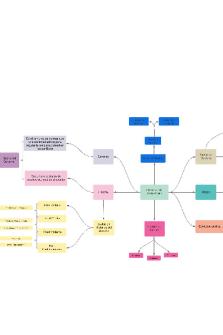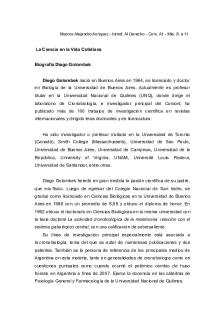The science of humour - Trabajo sobre la ciencia detrás del humor. En inglés. PDF

| Title | The science of humour - Trabajo sobre la ciencia detrás del humor. En inglés. |
|---|---|
| Course | Inglés |
| Institution | Universidad de Belgrano |
| Pages | 2 |
| File Size | 58.2 KB |
| File Type | |
| Total Downloads | 55 |
| Total Views | 177 |
Summary
Trabajo sobre la ciencia detrás del humor. En inglés....
Description
According to the Merriam-webster dictionary, humour can be defined as: 1. A funny or amusing quality. 2. The mental faculty of discovering, expressing or appreciating the ludicrous or absurdly incongruous (the ability to be funny or be amused by things that are funny). 3. Something that is or is designed to be comical or funny. What qualities make something funny (or not) is a question that philosophers have been attempting to answer for thousands of years. But a pair of psychological scientists have come up with a theory that explains why we might laugh at a dark joke about murder as well as a silly pun or play on words. Psychological scientists Peter McGraw (University of Colorado) and Caleb Warren (University of Arizona) propose that negativity is an intrinsic part of humor — without violating a norm or rule of some kind, a joke just isn’t funny. But violations can’t stray too far; otherwise, they become unappealing or even disgusting and upsetting. According to the researchers’ Benign Violation Theory, a violation is humorous when it breaks a rule or norm but is benign. For example, in a study published in Psychological Science, the researchers looked at the effect of psychological distance in terms of time. the research team investigated how the passage of time can influence one’s perception of an event as funny or painful. One study found that the events from people’s lives that became funnier over time were more severe events (like a car accident), while events that lost their comedic effect over time were seen as minor violations (like stubbing a toe). “Distance increases the humor in severe violations (i.e., tragedies), but decreases the humor in mild violations.” “These findings suggest that you have to get the right mix between how bad something is and how distant it is in order for it to be seen as a benign violation,” McGraw said. Prior research has found that humor can help facilitate recovery from stressful situations, even prolonging people’s tolerance for physical pain. In the business world, many successful organizations such as Zappos, Virgin, and Google deliberately build play areas into their workspaces and organize fun events to ameliorate the stressful nature of work, boost morale, and increase productivity. A study conducted by Australian National University management professors David Cheng and Lu Wang suggests that exposure to humorous stimuli may actually help people persevere in completing tedious tasks. After performing some studies, Cheng and Wang found that people who watched a funny video clip before a task spent approximately twice as long on a tiresome task compared with people who watched neutral or positive (but not funny) videos. In line with this idea, Cheng and Wang hypothesized that humor may provide a ‘mental break’ from tedious situations in the workplace that might not only prevent work-related
depletion, but also might facilitate the replenishment of mental resources, ultimately allowing people to persist longer on difficult tasks. To test this theory, for their first study the researchers recruited 74 students studying in a business class to come into the lab, ostensibly for an experiment on perception. First, the students performed a mentally depleting task in which they had to cross out every instance of the letter “e” contained in two pages of text. The students then were randomly assigned to watch a video clip eliciting either humor, contentment, or neutral emotions. Then the students completed a persistence task in which they played what amounted to an unwinnable game. The students were asked to guess the potential performance of employees based on provided profiles and were told that making 10 correct assessments in a row would lead to a win. However, the computer software was programmed such that it was nearly impossible to achieve 10 consecutive correct answers. Participants were allowed to quit the task at any time. Students who watched the humorous “Mr. Bean” video clip ended up spending significantly more time working on the task, making twice as many predictions as the other two groups.
Inspired by the classic Mark Twain quote, “Humor is tragedy plus time,”...
Similar Free PDFs

trabajo de la ciencia en su historia
- 19 Pages

LA Ciencia DEL Trabajo Social ( PEC)
- 10 Pages

Humor laws - The bests
- 1 Pages

Trabajo sobre la empatía
- 4 Pages
Popular Institutions
- Tinajero National High School - Annex
- Politeknik Caltex Riau
- Yokohama City University
- SGT University
- University of Al-Qadisiyah
- Divine Word College of Vigan
- Techniek College Rotterdam
- Universidade de Santiago
- Universiti Teknologi MARA Cawangan Johor Kampus Pasir Gudang
- Poltekkes Kemenkes Yogyakarta
- Baguio City National High School
- Colegio san marcos
- preparatoria uno
- Centro de Bachillerato Tecnológico Industrial y de Servicios No. 107
- Dalian Maritime University
- Quang Trung Secondary School
- Colegio Tecnológico en Informática
- Corporación Regional de Educación Superior
- Grupo CEDVA
- Dar Al Uloom University
- Centro de Estudios Preuniversitarios de la Universidad Nacional de Ingeniería
- 上智大学
- Aakash International School, Nuna Majara
- San Felipe Neri Catholic School
- Kang Chiao International School - New Taipei City
- Misamis Occidental National High School
- Institución Educativa Escuela Normal Juan Ladrilleros
- Kolehiyo ng Pantukan
- Batanes State College
- Instituto Continental
- Sekolah Menengah Kejuruan Kesehatan Kaltara (Tarakan)
- Colegio de La Inmaculada Concepcion - Cebu











